Decomposed Collaborative Modeling Approach for Probabilistic Fatigue Life Evaluation of Turbine Rotor
Abstract
:1. Introduction
2. Decomposed Collaborative Modeling Approach
2.1. Intelligent Kriging Modeling
2.1.1. Kriging Model Overview
2.1.2. Intelligent Algorithm
2.1.3. Intelligent Algorithm with Kriging Model, IKM
2.2. Decomposed Collaborative IKM, DCIKM
2.2.1. Basic thought of DCIKM
- Regarding the evaluation layer and response traits, the complex model with all input variables and total output response is divided into multiple simple submodels, each of which contains fewer input variables and one output response. It is assumed that the submodels are independent of each other.
- Considering the plasticity of materials, the thermal-structure coupling deterministic analysis is accomplished through FE simulation.
- The output responses of sub-models are obtained by importing several input variables into FE calculation, and the input variables and output responses are treated as training and testing data.
- With the extracted samples, the decomposed IKM of sub-models are constructed by the proposed IKM thought.
- Massive sampling for input variables is performed by Latin hypercube sampling (LHS) technique, and the statistical characteristics of output responses are obtained by decomposed IKM simulation.
- Taking the output responses of decomposed IKM models as the input variables, the collaborative IKM is established. By employing the simple DCIKM approach instead of time-consuming direct MC simulation, the probabilistic fatigue life evaluation is accomplished.
2.2.2. Mathematical Modeling of DCIKM
3. Probabilistic Fatigue Life Evaluation Theory
4. Case Study
4.1. Material Preparations
4.1.1. Finite Element Model
4.1.2. Variable Selection
4.2. Deterministic Fatigue Life Evaluation
4.3. Decomposed Stress-Strain Prediction
4.3.1. Decomposed IKM Modeling
4.3.2. Stress–Strain Prediction with Decomposed IKM Model
4.3.3. Sensitivity Analysis with Decomposed IKM Model
4.4. Collaborative Fatigue Life Evaluation
4.4.1. Collaborative IKM Modeling
4.4.2. Fatigue Life Evaluation with Collaborative IKM Model
4.4.3. Sensitivity Analysis with Collaborative IKM Model
4.5. Method Validations
5. Conclusions and Outlooks
- The simulation history and distribution characteristics of fatigue life are obtained and the reliability-based fatigue life Nf = 3296 cycles is recommended for the turbine rotor fatigue life design, which is conducive to greatly enhance the safety performance of turbine rotor.
- The sensitivity analysis results show that rotor speed and gas temperature are the main factors on mean stress, elastic strain range and plastic strain range, while plastic strain range and fatigue strength coefficient are the major factors on fatigue life, which provides a valuable guidance for further optimization of turbine rotor.
- Methods comparison (MCM, KM, IKM, and DCRSM, DCIKM) illustrates that the proposed DCIKM holds superiority in computing efficiency and accuracy. Accordingly, it is proved that the intelligent algorithm searching for optimal Kriging parameters is promising to build a higher-precision Kriging model. Moreover, the decomposed collaborative strategy is suitable to decrease the nonlinearity of probabilistic design of turbine rotor.
Author Contributions
Funding
Conflicts of Interest
References
- Zhu, S.P.; Xu, S.; Hao, M.F.; Liao, D.; Wang, Q. Stress-strain calculation and fatigue life assessment of V-shaped notches of turbine disk alloys. Eng. Fail. Anal. 2019, 106, 104187. [Google Scholar] [CrossRef]
- Zhu, S.P.; Huang, H.Z.; Peng, W.; Mahadevan, S. Probabilistic Physics of Failure-based framework for fatigue life prediction of aircraft gas turbine discs under uncertainty. Reliab. Eng. Syst. Saf. 2016, 146, 1–12. [Google Scholar] [CrossRef]
- Zhang, C.Y.; Wei, J.S.; Jing, H.Z.; Fei, C.W.; Tang, W.Z. Reliability-Based Low Fatigue Life Analysis of Turbine Blisk with Generalized Regression Extreme Neural Network Method. Materials 2019, 12, 1545. [Google Scholar] [CrossRef] [PubMed] [Green Version]
- Mao, J.X.; Hu, D.Y.; Li, D.; Wang, R.Q.; Song, J. Novel adaptive surrogate model based on LRPIM for probabilistic analysis of turbine disc. Aerosp. Sci. Technol. 2017, 70, 76–87. [Google Scholar] [CrossRef]
- Zhu, S.P.; Liu, Q.; Zhou, J.; Yu, Z.Y. Fatigue reliability assessment of turbine discs under multi-source uncertainties. Fatigue Fract. Eng. Mater. Struct. 2018, 41, 1291–1305. [Google Scholar] [CrossRef]
- Zhu, S.P.; Liu, Q.; Lei, Q.; Wang, Q.Y. Probabilistic fatigue life prediction and reliability assessment of a high pressure turbine disc considering load variations. Int. J. Damage Mech. 2018, 27, 1569–1588. [Google Scholar] [CrossRef]
- Penmetsa, R.C.; Grandhi, R.V. Adaptation of fast Fourier transformations to estimate structural failure probability. Finite Elem. Anal. Des. 2003, 39, 473–485. [Google Scholar] [CrossRef]
- Song, L.K.; Fei, C.W.; Bai, G.C.; Yu, L.C. Dynamic neural network method-based improved PSO and BR algorithms for transient probabilistic analysis of flexible mechanism. Adv. Eng. Inf. 2017, 33, 144–153. [Google Scholar] [CrossRef]
- Helton, J.C.; Davis, F.J. Latin hypercube sampling and the propagation of uncertainty in analyses of complex systems. Reliab. Eng. Syst. Saf. 2003, 81, 23–69. [Google Scholar] [CrossRef] [Green Version]
- Zhang, C.Y.; Yuan, Z.S.; Wang, Z.; Fei, C.W.; Lu, C. Probabilistic Fatigue/Creep Optimization of Turbine Bladed Disk with Fuzzy Multi-Extremum Response Surface Method. Materials 2019, 12, 3367. [Google Scholar] [CrossRef] [Green Version]
- Duprat, F.; Sellier, A. Probabilistic approach to corrosion risk due to carbonation via an adaptive response surface method. Probab. Eng. Mech. 2006, 21, 207–216. [Google Scholar] [CrossRef]
- Song, L.K.; Fei, C.W.; Wen, J.; Bai, G.C. Multi-objective reliability-based design optimization approach of complex structure with multi-failure modes. Aerosp. Sci. Technol. 2017, 64, 52–62. [Google Scholar] [CrossRef]
- Maliki, M.; Bruno, S. Surrogate-assisted reliability-based design optimization: A survey and a unified modular framework. Struct. Multidiscip. Optim. 2019, 60, 2157–2176. [Google Scholar]
- Fei, C.W.; Choy, Y.S.; Hu, D.Y.; Bai, G.C.; Tang, W.Z. Dynamic probabilistic design approach of high pressure turbine blade-tip radial running clearance. Nonlinear Dyn. 2016, 86, 205–223. [Google Scholar] [CrossRef]
- Yeh, W.C.; Su, J.C.P.; Hsieh, T.J.; Chih, M.; Liu, S.L. Approximate reliability function based on wavelet Latin hypercube sampling and bee recurrent neural network. IEEE Trans. Reliab. 2011, 60, 404–414. [Google Scholar] [CrossRef]
- Song, L.K.; Bai, G.C.; Fei, C.W. Probabilistic LCF life assessment for turbine discs with DC strategy-based wavelet neural network regression. Int. J. Fatigue 2019, 119, 204–219. [Google Scholar] [CrossRef]
- Li, T.Z.; Yang, X.L. An efficient uniform design for Kriging-based response surface method and its application. Comput. Geo. 2019, 109, 12–22. [Google Scholar] [CrossRef]
- Gaspar, B.; Teixeira, A.P.; Soares, C.G. Assessment of the efficiency of Kriging surrogate models for structural reliability analysis. Probab. Eng. Mech. 2014, 37, 24–34. [Google Scholar] [CrossRef]
- Wen, Z.X.; Pei, H.Q.; Liu, H.; Yue, Z.F. A sequential Kriging reliability analysis method with characteristics of adaptive sampling regions and parallelizability. Reliab. Eng. Syst. Saf. 2016, 153, 170–179. [Google Scholar] [CrossRef]
- Martin, J.D.; Simpson, T.W. Use of Kriging models to approximate deterministic computer models. AIAA J. 2005, 43, 853–863. [Google Scholar] [CrossRef]
- Song, L.K.; Bai, G.C.; Fei, C.W. Dynamic surrogate modeling approach for probabilistic creep-fatigue life evaluation of turbine disks. Aerosp. Sci. Technol. 2019, 95, 105439. [Google Scholar] [CrossRef]
- Li, M.G.; Li, M.; Han, G.P.; Liu, N.; Zhang, Q.M.; Wang, Y. Optimization Analysis of the Energy Management Strategy of the New Energy Hybrid 100% Low-Floor Tramcar Using a Genetic Algorithm. Appl. Sci. 2018, 8, 1144. [Google Scholar] [CrossRef] [Green Version]
- Lu, R.L.; Guan, X.M.; Li, X.Y.; Hwang, I. A large-scale flight multi-objective assignment approach based on multi-island parallel evolution algorithm with cooperative coevolutionary. Sci. China Inf. Sci. 2016, 59, 1–17. [Google Scholar] [CrossRef]
- Li, C.C.; Lin, C.H.; Liu, J.C. Parallel genetic algorithms on the graphics processing units using island model and simulated annealing. Adv. Mech. Eng. 2017, 9, 1–14. [Google Scholar] [CrossRef] [Green Version]
- Heungseob, K.; Pansoo, K. Reliability–redundancy allocation problem considering optimal redundancy strategy using parallel genetic algorithm. Reliab. Eng. Syst. Saf. 2017, 159, 153–160. [Google Scholar]
- Fei, C.W.; Bai, G.C. Distributed collaborative extremum response surface method for mechanical dynamic assembly reliability analysis. J. Cent. South Univ. 2013, 20, 2414–2422. [Google Scholar] [CrossRef]
- Liu, C.L.; Lu, Z.Z.; Xu, Y.L.; Yue, Z.F. Reliability analysis for low cycle fatigue life of the aeronautical engine turbine disc structure under random environment. Mater. Sci. Eng. A. 2005, 395, 218–225. [Google Scholar] [CrossRef]
- Zhu, S.P.; Foletti, S.; Berrtta, S. Probabilistic framework for multiaxial LCF assessment under material variability. Int. J. Fatigue 2017, 103, 371–385. [Google Scholar] [CrossRef] [Green Version]
- Bai, G.C.; Fei, C.W. Distributed collaborative response surface method for mechanical dynamic assembly reliability design. Chin. J. Mech. Eng. 2013, 26, 1160–1168. [Google Scholar] [CrossRef]
- Song, L.K.; Bai, G.C.; Fei, C.W. Multi-failure probabilistic design for turbine bladed disks using neural network regression with distributed collaborative strategy. Aerosp. Sci. Technol. 2019, 92, 464–477. [Google Scholar] [CrossRef]
- Fei, C.W.; Tang, W.Z.; Bai, G.C. Novel method and model for dynamic reliability optimal design of turbine blade deformation. Aerosp. Sci. Technol. 2014, 39, 588–595. [Google Scholar] [CrossRef]
- Gao, H.F.; Fei, C.W.; Bai, G.C.; Ding, L. Reliability-based low-cycle fatigue damage analysis for turbine blade with thermo-structural interaction. Aerosp. Sci. Technol. 2016, 49, 289–300. [Google Scholar] [CrossRef]
- Kriging, D.G. A statistical approach to some basic mine valuations problems on the Witwatersrand. Journal of the Chemical. Metall. Min. Eng. Soc. S. Afr. 1951, 52, 119–139. [Google Scholar]
- Matheron, G.M. Principles of geostatistics. Econ. Geogr. 1963, 58, 1246–1266. [Google Scholar] [CrossRef]
- Kaymaz, I. Application of kriging method to structural reliability problems. Struct. Saf. 2005, 27, 133–151. [Google Scholar] [CrossRef]
- Echard, B.; Gayton, N.; Lemaire, M. AK-MCS: An active learning reliability method combining Kriging and Monte Carlo simulation. Struct. Saf. 2011, 33, 145–154. [Google Scholar] [CrossRef]
- Keys, A.C.; Rees, L.P.; Greenwood, A.G. Performance measures for selection of metamodels to be used in simulation optimization. Dec. Sci. 2002, 33, 31–57. [Google Scholar] [CrossRef]
- Hu, F.G.; Zhan, J.H.; Feng, L.Y. Sparse planar retrodirective antenna array using improved adaptive genetic algorithm. J. Electr. Sci. Technol. 2011, 9, 265–269. [Google Scholar]
- Gao, H.F.; Bai, G.C.; Gao, Y.; Bao, T.W. Reliability analysis for aeroengine turbine disc fatigue life with multiple random variables based on distributed collaborative response surface method. J. Cent. South Univ. 2015, 22, 4693–4701. [Google Scholar] [CrossRef]
- Song, L.K.; Wen, J.; Fei, C.W.; Bai, G.C. Distributed collaborative probabilistic design of multi-failure structure with fluid-structure interaction using fuzzy neural network of regression. Mech. Syst. Signal Process. 2018, 104, 72–86. [Google Scholar] [CrossRef]
- Song, L.K.; Bai, G.C. Multi-Surrogate Collaboration Approach for Creep-Fatigue Reliability Assessment of Turbine Rotor. IEEE Access. 2020, 8, 39861–39874. [Google Scholar] [CrossRef]
- Coffin, L.F. A study of the effects of cyclic thermal stress on a ductile metal. Trans. Am. Soc. Mech. Eng. 1954, 76, 931–950. [Google Scholar]
- Wang, R.Q.; Liu, X.; Hu, D.Y.; Meng, F.C.; Li, D.; Li, B. Zone-based reliability analysis on fatigue life of GH720Li turbine disk concerning uncertainty quantification. Aerosp. Sci. Technol. 2017, 70, 300–309. [Google Scholar] [CrossRef]
- Gao, H.F.; Wang, A.; Zio, E.; Bai, G.C. An integrated reliability approach with improved importance sampling for low-cycle fatigue damage prediction of turbine disks. Reliab. Eng. Syst. Saf. 2020, 199, 106819. [Google Scholar] [CrossRef]
- Abyani, M.; Bahaari, M.R. A comparative reliability study of corroded pipelines based on Monte Carlo Simulation and Latin Hypercube Sampling methods. Int. J. Press. Vessel. Pip. 2020, 181, 104079. [Google Scholar] [CrossRef]
- Kang, F.; Xu, Q.; Li, J.J. Slope reliability analysis using surrogate models via new support vector machines with swarm intelligence. Appl. Math. Model. 2016, 40, 6105–6120. [Google Scholar] [CrossRef]






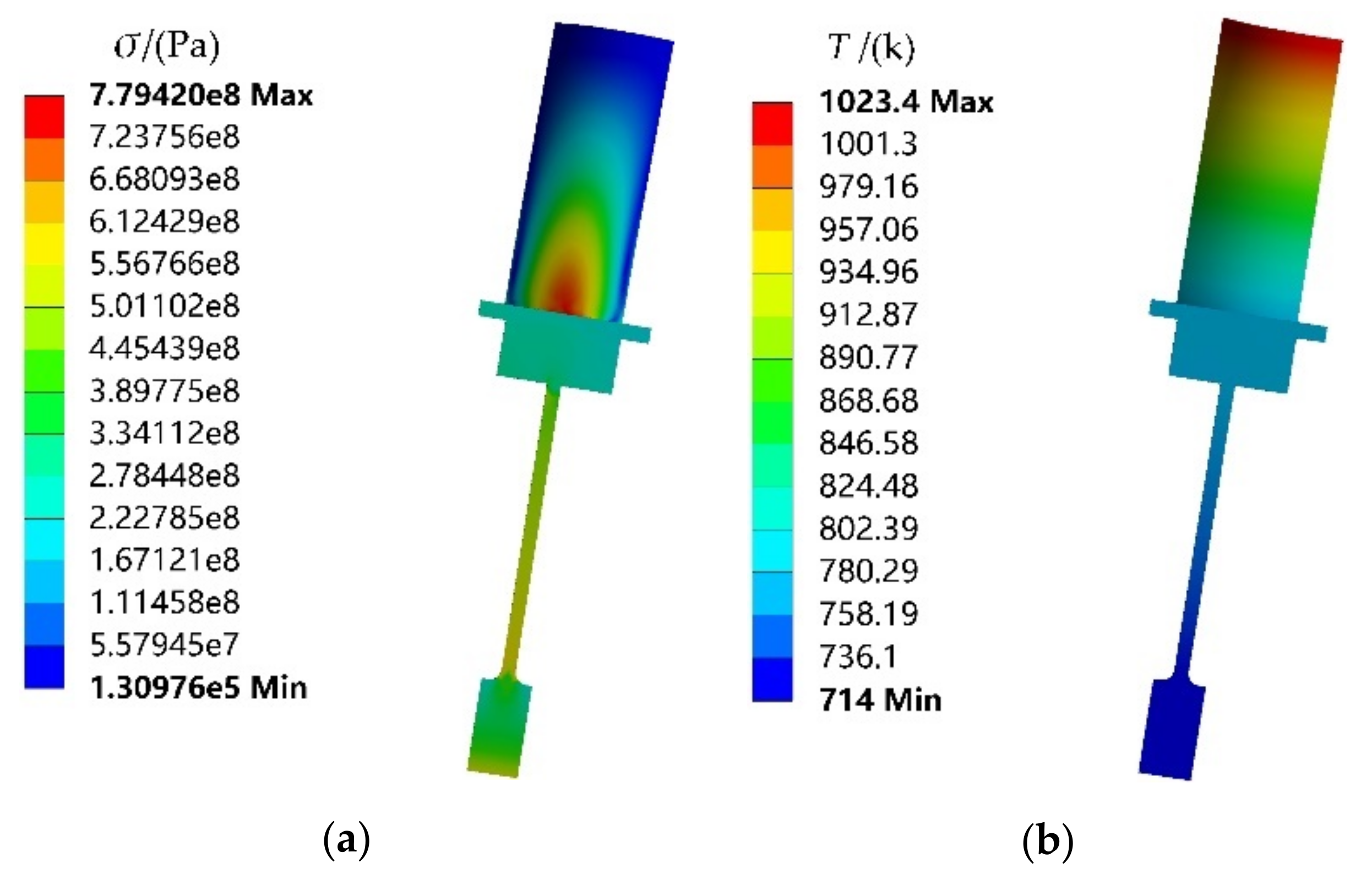

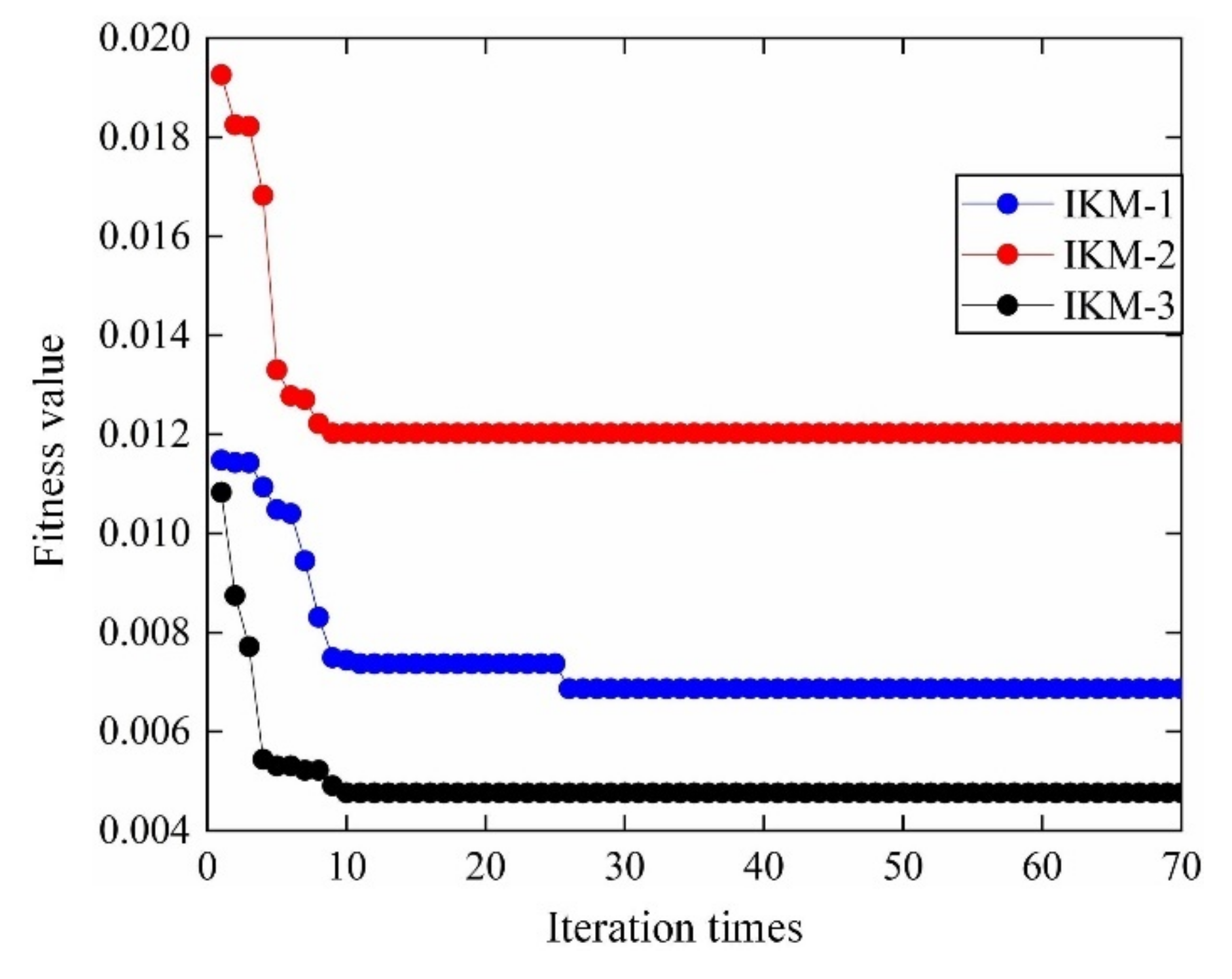

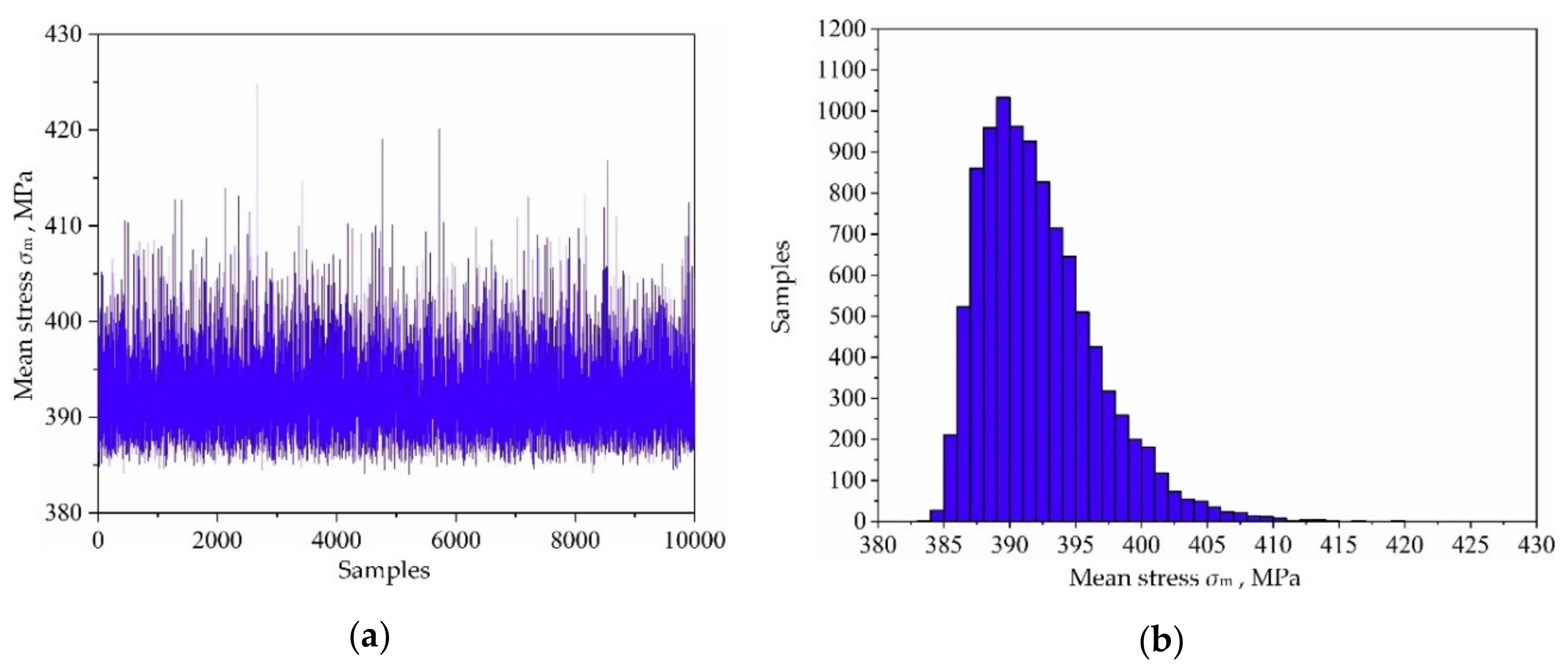
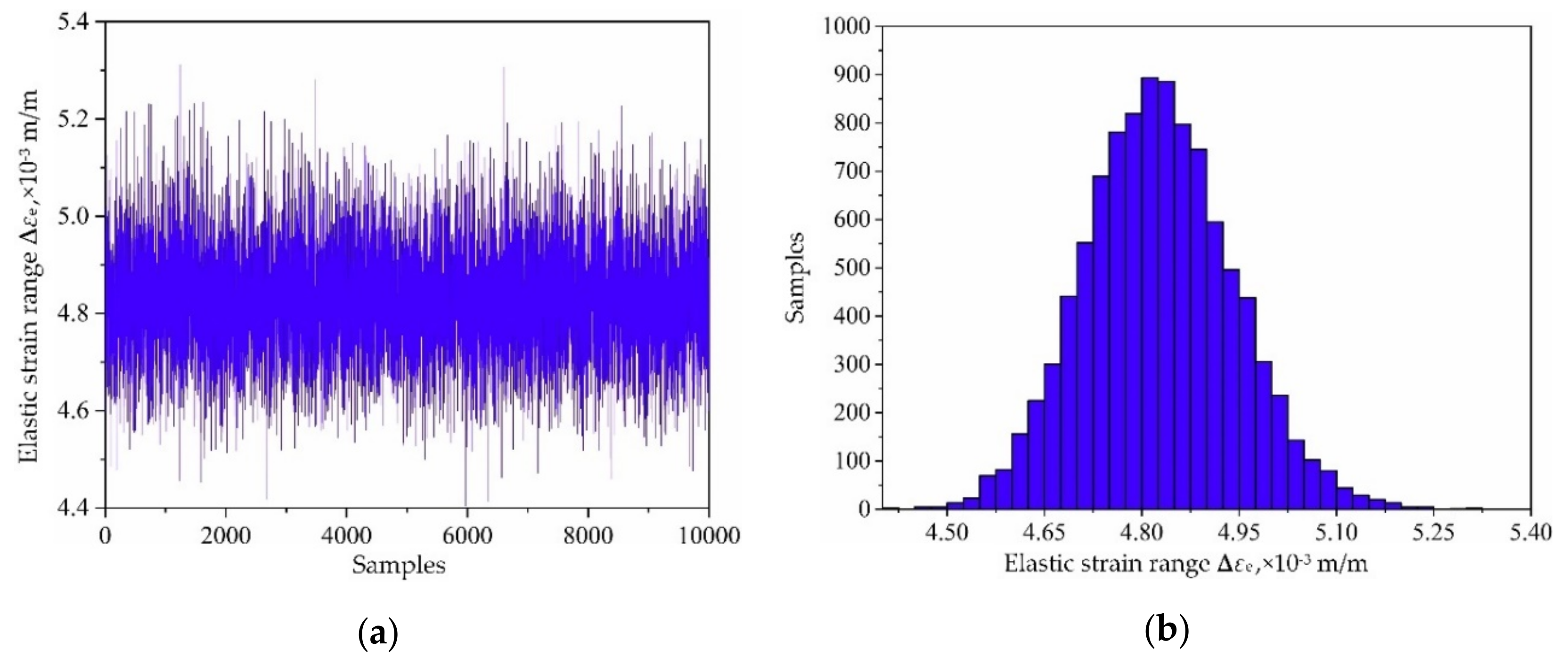
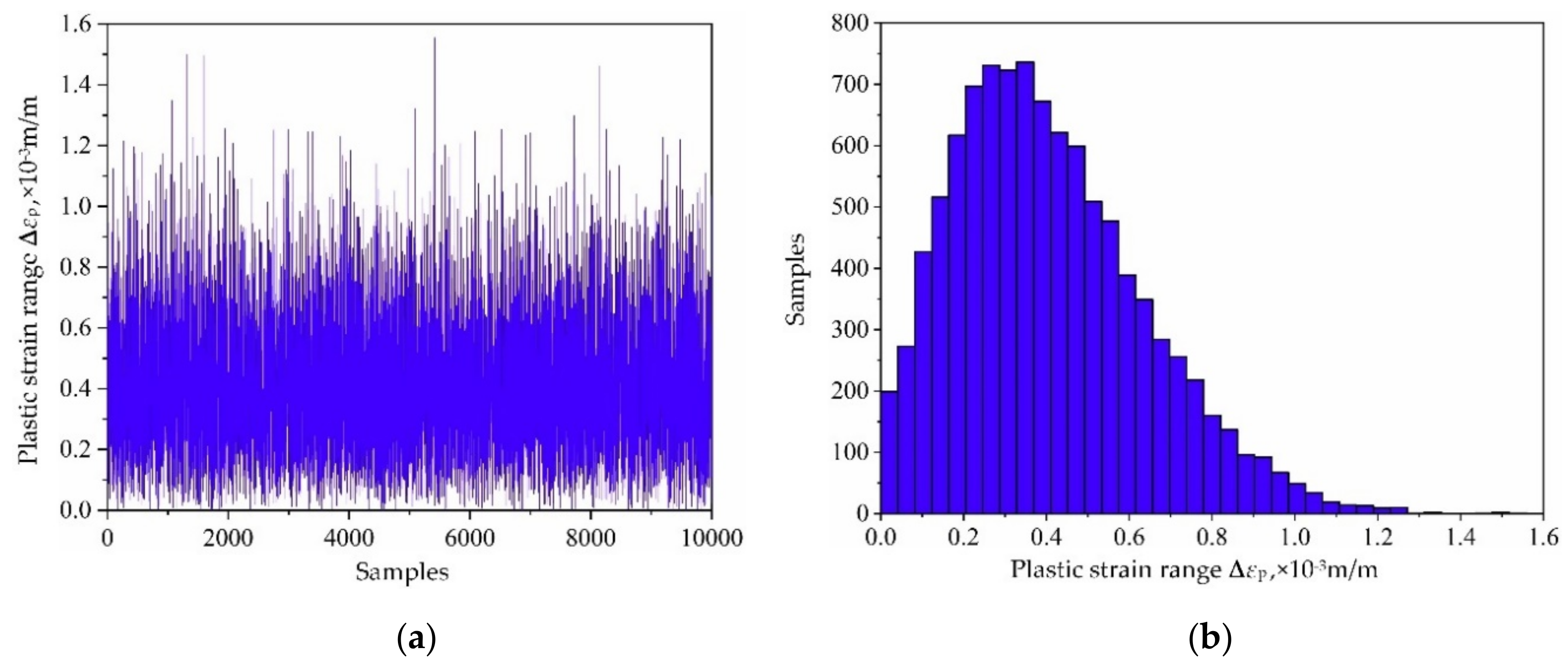
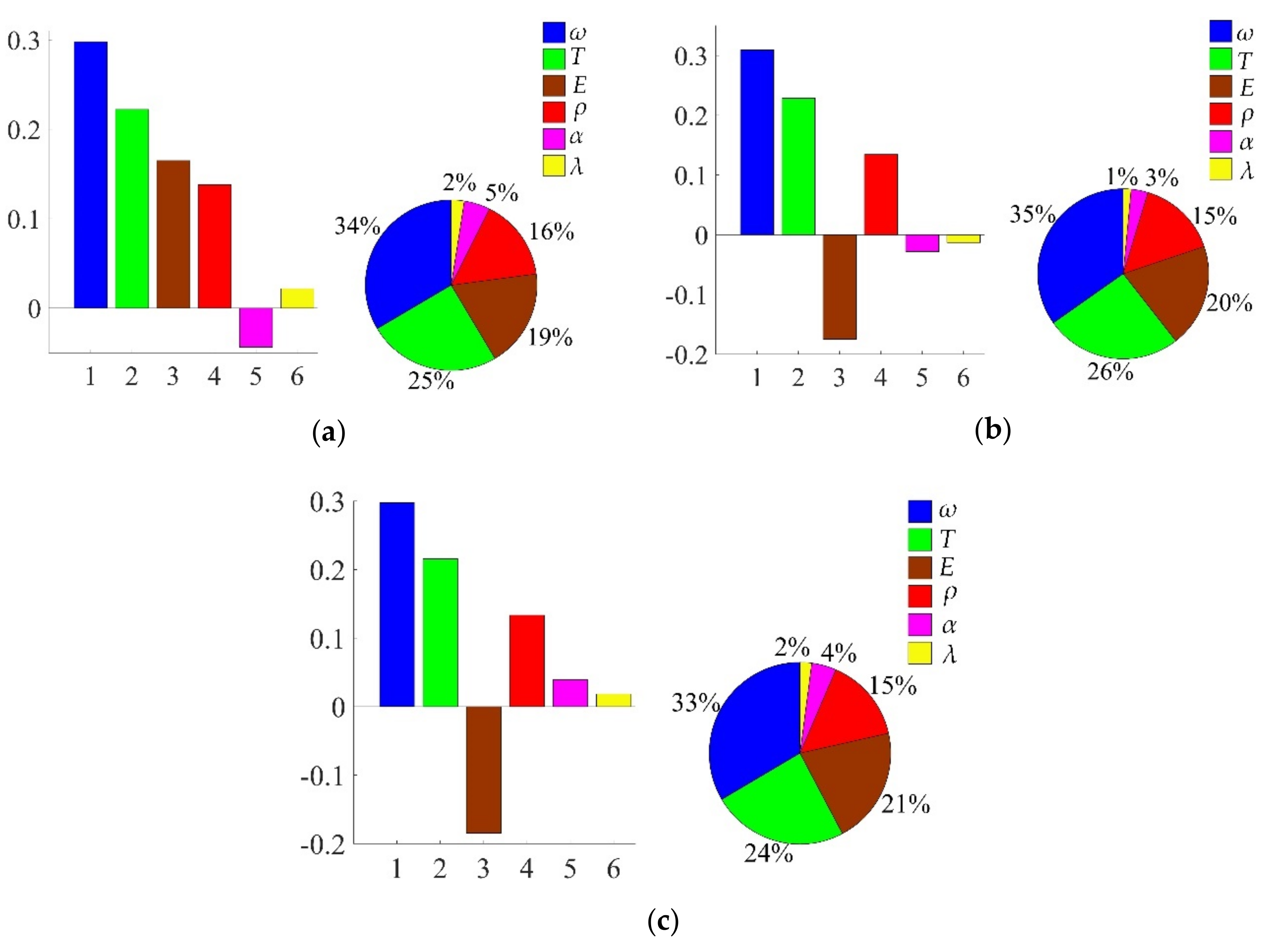


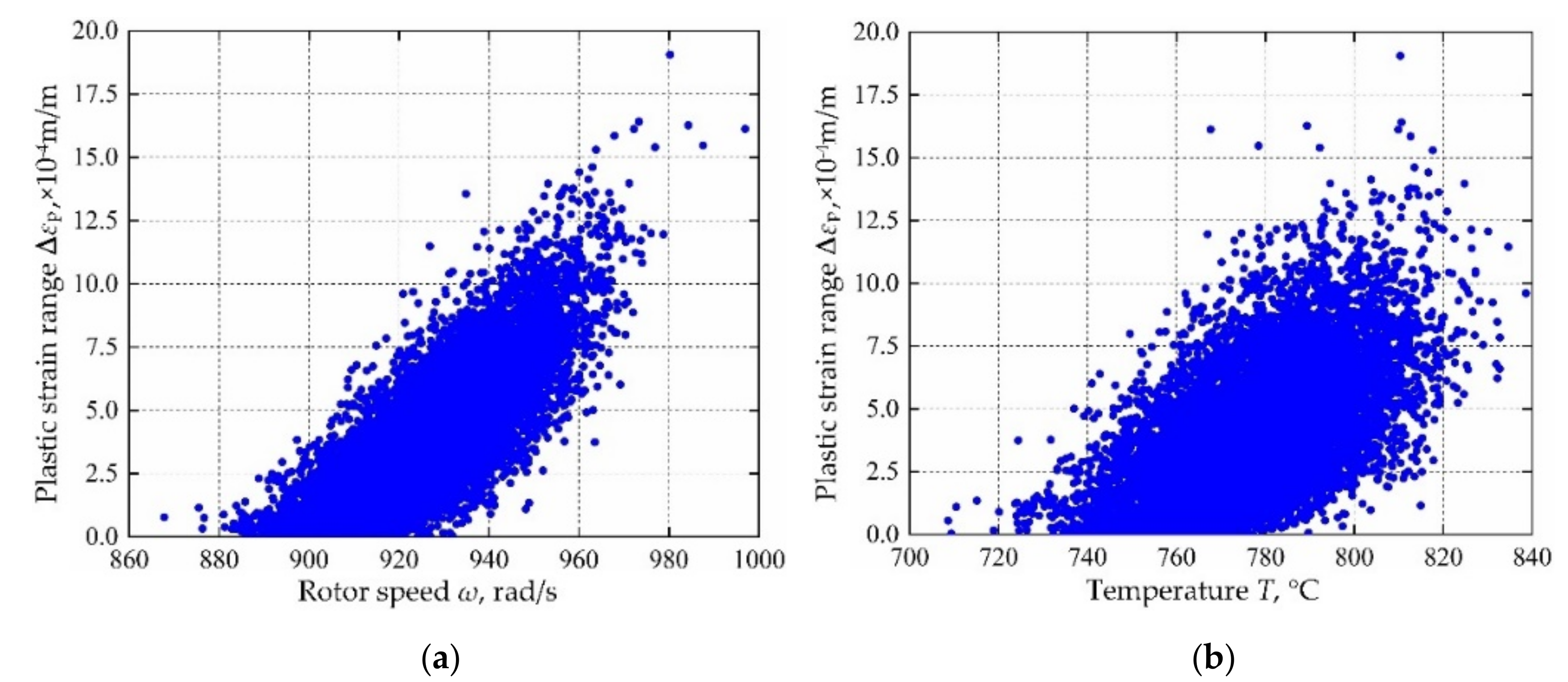



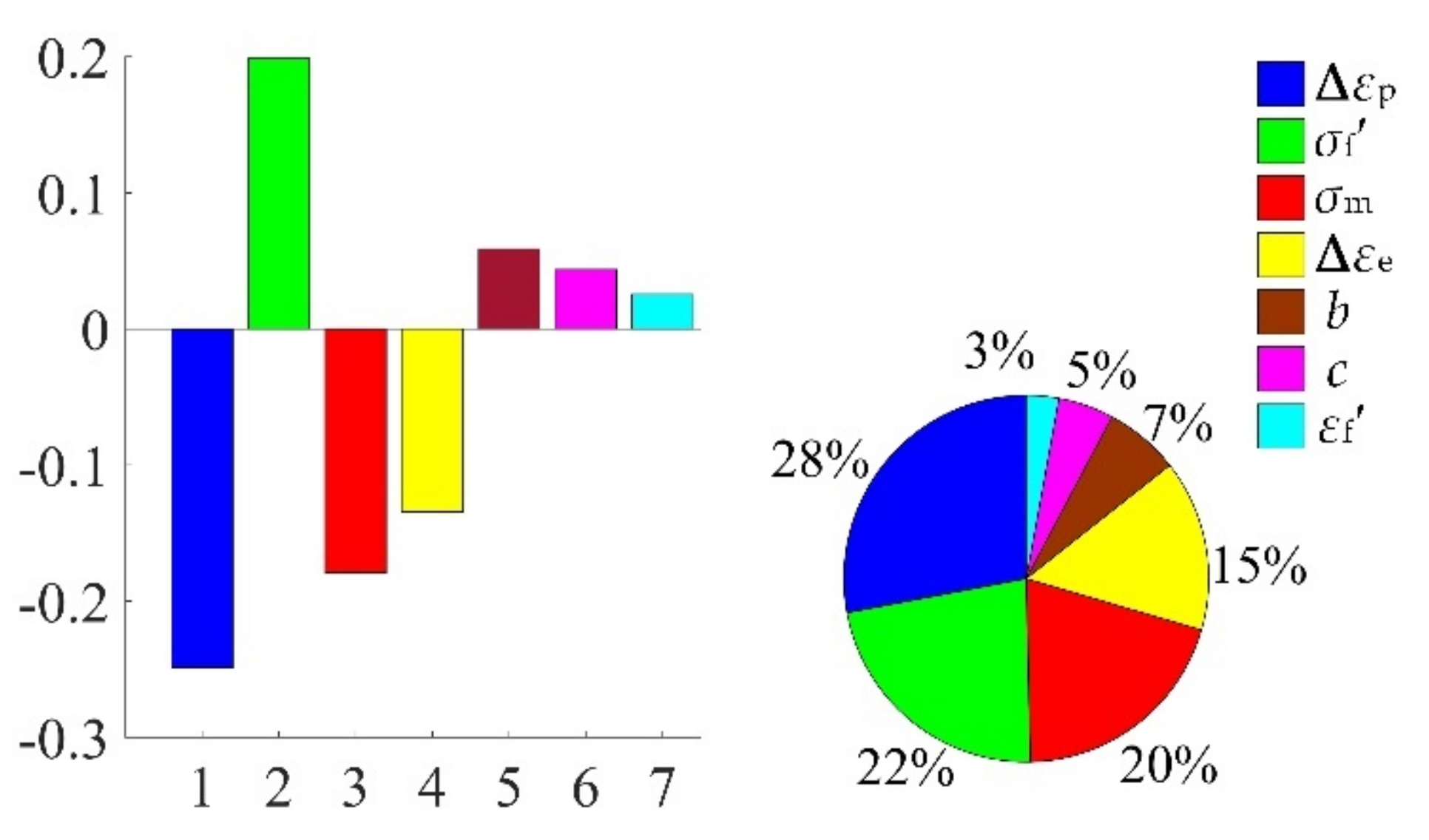

| Random Variables | Mean | Standard Deviation | Distribution |
|---|---|---|---|
| Rotate speed ω, rad/s | 922 | 18.4 | Normal |
| Gas temperature T, k | 773.2 | 15.5 | Normal |
| Density ρ, 10−9 t/mm3 | 8.21 | 0.164 | Normal |
| Modulus of elasticity E, GPa | 163 | 3.26 | Normal |
| Heat conductivity λ, W/(m °C) | 21.4 | 0.428 | Normal |
| Thermal expansion coefficient α, 10−6 °C | 13.8 | 0.276 | Normal |
| Random Variables | Mean | Standard Deviation | Distribution |
|---|---|---|---|
| Fatigue strength index b | −0.1 | 0.002 | Normal |
| Fatigue ductility index c | −0.84 | 0.0168 | Normal |
| Fatigue strength coefficient σf′ | 1419 | 28.38 | Normal |
| Fatigue ductility coefficient εf′ | 0.505 | 0.0101 | Lognormal |
| Temperature (°C) | 100 | 200 | 300 | 400 | 500 | 600 | 700 | 800 | 900 |
|---|---|---|---|---|---|---|---|---|---|
| E, GPa | 205 | 196 | 182 | 173 | 163 | 163 | 159 | 141 | 134 |
| λ, W/m °C | 12.1 | 14.2 | 16.7 | 18.8 | 21.4 | 23.7 | 26.2 | 27.6 | 28.9 |
| α, 10−6 °C | 11.6 | 12.3 | 12.4 | 13.3 | 13.8 | 14.4 | 15.1 | 15.7 | 16.5 |
| n | MCM | KM | IKM | DCRSM | DCIKM | |||
|---|---|---|---|---|---|---|---|---|
| Time, s | Time, s | Time, s | Improved Efficiency, % | Time, s | Improved Efficiency, % | Time, s | Improved Efficiency, % | |
| 102 | 5754 | 45.7 | 40.1 | 12.25 | 31.9 | 30.19 | 22.7 | 50.33 |
| 103 | 60,890 | 47.1 | 41.2 | 12.53 | 32.8 | 30.36 | 23.2 | 50.74 |
| 104 | 798,954 | 49.8 | 43.1 | 13.65 | 34.6 | 30.52 | 24.5 | 50.80 |
| 105 | — | 58.7 | 50.4 | 14.14 | 39.7 | 32.37 | 28.3 | 51.79 |
| n | MCM | KM | IKM | DCRSM | DCIKM | ||||
|---|---|---|---|---|---|---|---|---|---|
| Reliability | Reliability | Precision, % | Reliability | Precision, % | Reliability | Precision, % | Reliability | Precision, % | |
| 102 | 0.92 | 0.81 | 88.04 | 0.90 | 97.83 | 0.87 | 94.57 | 0.91 | 98.91 |
| 103 | 0.984 | 0.915 | 92.99 | 0.971 | 98.68 | 0.942 | 95.73 | 0.975 | 99.09 |
| 104 | 0.9977 | 0.9521 | 95.43 | 0.9969 | 99.92 | 0.9731 | 97.53 | 0.9972 | 99.95 |
| 105 | — | 0.9579 | 96.01 | 0.9971 | 99.94 | 0.9739 | 97.61 | 0.9970 | 99.93 |
© 2020 by the authors. Licensee MDPI, Basel, Switzerland. This article is an open access article distributed under the terms and conditions of the Creative Commons Attribution (CC BY) license (http://creativecommons.org/licenses/by/4.0/).
Share and Cite
Huang, Y.; Bai, G.-C.; Song, L.-K.; Wang, B.-W. Decomposed Collaborative Modeling Approach for Probabilistic Fatigue Life Evaluation of Turbine Rotor. Materials 2020, 13, 3239. https://doi.org/10.3390/ma13143239
Huang Y, Bai G-C, Song L-K, Wang B-W. Decomposed Collaborative Modeling Approach for Probabilistic Fatigue Life Evaluation of Turbine Rotor. Materials. 2020; 13(14):3239. https://doi.org/10.3390/ma13143239
Chicago/Turabian StyleHuang, Ying, Guang-Chen Bai, Lu-Kai Song, and Bo-Wei Wang. 2020. "Decomposed Collaborative Modeling Approach for Probabilistic Fatigue Life Evaluation of Turbine Rotor" Materials 13, no. 14: 3239. https://doi.org/10.3390/ma13143239




